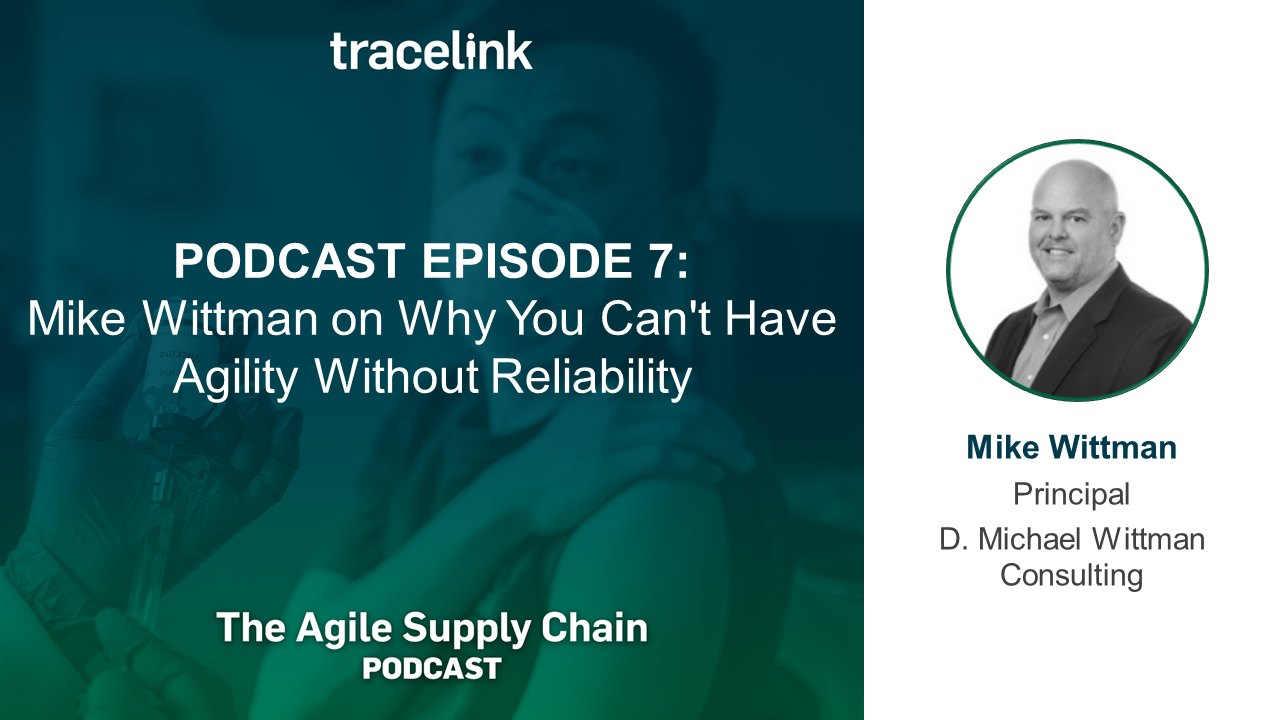Table of contents
Key Takeaways
- To achieve resilience, you first need a predictable foundation and a clear understanding of variables you cannot control.
- To plan the future, you need to fully understand your current capabilities, and ensure that you can reliably deliver against that capability.
- The age‑old axiom, "people, process, technology," is as relevant as ever when it comes to achieving agility and resilience.

"You can't have agility without reliability." In this episode of The Agile Supply Chain Podcast, supply chain leader Mike Wittman shares insights from nearly three decades at Johnson & Johnson.
Transcript:
Roddy Martin: Mike, talk a little bit about your roles. I know you've come up through the ranks and led great big supply chains like Pinnacle and Mars, and now, helping pharma companies in their supply chains. Talk a little bit about your experience in how you've evolved your understanding of agility and how to build it.
Welcome once again to the TraceLink "Thought Leader" series.
Mike Wittman: My background. I've got 40 years of experience in supply chain. Started off on the shop floor as an operator right out of high school, making Tylenol on third shift. Didn't get much more ground floor than that. I describe my supply chain experience from being top to bottom and side to side.
Then I went from the shop floor all the way up to chief supply chain officer for Pinnacle Foods. It's my last role and side to side. I've worked functionally in planning, sourcing, manufacturing, delivery, technology. My degrees in accounting, so I've a good financial background, really side to side and top to bottom.
I spent the first almost 30 years of my career with Johnson & Johnson where my last role was running the supply chain for their consumer business in North America, about an eight‑billion‑dollar‑business.
Then moved over to the food industry and spent the last 10 years running supply chains for Mars chocolate business in North America, and then as the chief supply chain officer for Pinnacle Foods, which is the center of store grocery business and was the number two player in frozen foods before their acquisition a couple of years ago by Conagra.
Roddy: How have you seen agility evolved in the days when we were all supply‑driven? Agility was almost in the same connotation as Lean. How fast can you get it to the shelf? Now, we're saying, how fast can you recover from the disruption, which is a very different perspective to agile and supply chain? How have you seen that evolved?
Mike: It's a great question, Roddy. I had an interesting upbringing because I spent the first 20 years of my career in the Tylenol business. I was in the factory that made the Tylenol that was tampered with in 1982 and in 1986 where there were unfortunate deaths associated with that tampering. I was there when the FBI and the FDA showed up to start the investigation.
The idea of responding, being resilient, and responding to unplanned anomalies in the marketplace is actually not new. It's just at a whole new level, I think, because of the scale of the COVID response that we've seen lately, being a global pandemic.
It's not a new concept. I had the benefit of going through...If there can be a benefit to really terrible things like that, I had the benefit of going through that personally being part of the team that had to respond, both as an operator and a supervisor back in those days, and handling some of the scheduling to that major disruption in our supply chain and our manufacturing capabilities.
I take that and I piece together my experience over the years in methodologies ranging all the way back to quality circles, and learning the difference between a corrective response or a corrective action and a preventive action making sure something never happens again.
Having a separate focus between those two, all the way through the Six Sigma and Lean work that I did with Johnson & Johnson and applying those tools all along the way.
This concept of agility and resiliency is not new. I think we've just recently experienced it on a scale that was really unimaginable for us as a global pandemic through COVID.
It's illustrated for businesses like life science businesses, and pharmaceuticals, medical devices, that while the development cycles, and frankly, the approval cycles for their drugs or for the devices may be significantly longer than really what I've experienced on the CPG side or what the tech industry experiences.
That doesn't mean that you can have your mindset be one where you think in term of months and years when other industries have been thinking in terms of days and weeks. Post‑COVID, we have to think in terms of hours and our response in this.
We may not be able to turn on or turn off a supply chain within a few hours, but we need to be able to make decisions, make future commitments. Whether it's to customers...I have a firm that I'm doing some work with that's a major provider of drugs to the government in the COVID response.
The head of supply chain literally gets a phone call from senior government officials and heads of the CDC and needs to have a response within an hour. The scale and the speed of resiliency, I think, has changed dramatically. The scale of the need for resiliency has changed dramatically.
Roddy: What's really interesting is if you just go back five years, visibility was the Holy Grail in end‑to‑end supply chain. We said, "Well, we can't see upstream and we can't see downstream." It generally referred to product. We can't see where our inventory is. We can't see what the CMOs (contract manufacturers) are delivering, etc., etc.
As we've gone further down the road of living through COVID‑19, we start to understand that actually, yes, it is about the product and visibility of the product. Most importantly, it's about visibility of the disruptive event. You can't have agility without reliability.
Mike: That's true.
Roddy: I want you to play on that, because I think anybody sitting listening, saying, "Hey, I got to build agility. We aren't that resilient. We've demonstrated that we broke down a couple places in our supply chain. I got to figure out where to start."
I want you to start at the point of, where are you cracking and building your base understanding of your own reliability, because it's not magic, right? You can't certainly produce the product if you've got unreliable supply. Bottom line, there's certain things that just don't work.
Talk a little bit about that reliability and how every site has issues. Every manufacturing company has issues they have to deal with. Some are serious. Some are not serious. You've got to figure it out and look at it in terms of reliability.
Let me ask you to talk a little bit about your experience in that sense.
Mike: I've mentioned that during my time driving Six Sigma and Lean at J&J, one of the back‑of‑the‑envelope exercises I wanted to understand, when we talked about defects per million and opportunities for failure was how many opportunities there were in a supply chain to fail.
Our supply chain was not a huge supply chain. I did the back‑of‑the‑envelope calculation.
If you actually think about all the individual pieces of equipment, all the individual materials, all the transactions going on every day, the different items that are being run on the lines that can fail, the quality attributes, etc., we came up with an estimate of between three and five hundred thousand opportunities for failure in our supply chain on a given day.
It was a massive number. When you've got that many opportunities, you have to have fundamental reliability as the foundation for agility and resilience.
When I think about agility, agility for me is a bit more planned. It's an opportunity to say, "Where do I want to be flexible and where do I not? How quickly do I need to respond, and what do I want to build capabilities around that," where resiliency is really about responding to the unplanned.
If I think about that being planned versus unplanned, it's ‑‑ from a reliability perspective, in order to plan the future, I need to know what my current capability is. I need to know that I can reliably deliver against that capability.
That doesn't have to be perfection, certainly, but it has to be at a high enough level where the majority of the time, I can deliver against my requirements, primarily to my customers and consumers more than anyone else, but also to the internal nodes that eventually link together in partnership to deliver to those customers.
Then in order for me to be resilient and respond to the unplanned, I need to have a predictable foundation. As I need to react and change, I need to know what I know and can rely on, and I need to know what the variables are that I cannot control, so that I can then start to attack those uncontrolled variables.
If I have things that are out of my control that should be within my control, like my fundamental OAE performance in manufacturing or my adherence to schedule, my ability to make in Manufacturing at the item level what was planned for me in the time frame that it was planned ‑‑ if I can't do those at a fairly high level ‑‑ let's say at least in the 90 percent range on adherence to schedule, certainly in the upper 60s to 70 percent range on operational equipment effectiveness, then I don't have a predictable supply chain that I can rely on.
When an unplanned event hits me, it's going to knock me much further off balance and throw the whole system out of whack than if I have a pretty resilient supply chain or capable, reliable supply chain.
When I get hit by a punch, it's going to hurt, and I'm going to flinch a little bit, but I know that I can take that punch, because I've been through it before, I've got a fundamentally sound and reliable supply chain.
That's built at the ground level, from my suppliers all the way through my manufacturing plants into my distribution logistics channel. It's knit together in my planning organization.
Roddy: As you were talking about reliability, my mind crossed back to my South African Breweries (SAB), better days when they had sites all over the world. One of the goals was to be able to put the performance of every single site on a matrix of two dimensions, and to be able to look at every site in the world and how they were performing.
The point was that you wanted standardized problem‑solving processes. Now, I'm not talking about militaristic problem‑solving processes. I'm just talking about if everybody is having this kind of a problem with this kind of piece of packaging equipment, let's not all solve these things separately. Let's try and share.
My question is, how well do you think companies are codifying that standard approach to managing issues across their operations?
Or are people generally running around the day after, like chickens without heads, scrambling to fix problems and get the system up and running and saying, "Thank goodness, we got that event out of the way. Let's sit and wait for the next event"? How well do you think it's been codified?
Mike: Of course, Roddy, it's all over the place. You can't stereotype and say, as an industry, it's either good or bad. It depends on an individual company, the level of resources, the attention that they put to it, an effort against it, and more than anything else, quite frankly, that's all driven by their experience.
For those companies that have had some significant negative experiences, they put a lot more energy against codifying than those that haven't. I would say, secondly, it depends on their focus on process.
In my experience, companies generally, we talked about the people, process, technology, leadership now attributes or dimensions of a business, but culturally, businesses tend to be either more people‑oriented or more process‑oriented.
I hear that a lot spoken that way in firms that I was at, which tended to be more people‑oriented. My approach was to bring more process to balance the people. When I say people‑oriented, it's they rely on people and the brains.
The philosophy is, if I bring smart people into a room, we can figure this out. That's absolutely true. That's step one. Bring smart people into the room and figure it out.
But then once you figure it out, document it, codify it, put it into a process because particularly in supply chain when everything is repeated thousands, millions of times, you need to have a repeatable process. That's what gives you reliability. It's knowing that you can follow the same process and get the same outcome every time ‑‑ the opposite of insanity.
You have to take both of those steps. It takes a balance of the people focus and the process focus. Then we all know, in my view, technology is the enabler for that.
Technology becomes a method or a tool that allows us not only to codify many of those processes, but then to also enforce the processes ‑‑ if you use the technology, you can't violate the process, in many cases ‑‑ and to be able to measure performance, get real‑time information and get insights and visibility into it.
That's why it's a very age‑old axiom, people, process, technology, but I still love it today. I think it applies very appropriately in this world of agility and resilience. Then I've recently added the leadership, the fourth leg of that stool.
Roddy: I like that, by the way. I think it's very true.
Mike: It's because it's a driving change. I was a big believer that you create the process, and then you figure out who are the people, what are the people skills that are necessary to execute the process, and then you enable it with technology. There was a logical sequence to attacking those three dimensions.
Then what I learned was it took way too long and the real linchpin for driving speed, which is a key element in agility and resiliency, was to have the right leadership. You got to have the right leaders in place.
When you want to drive change, you need some of those leaders. You need all of them to be receptive to the change. You need all of them to be focused, and energized, and inspired by the change. But you need some of them who have experience with the change. Who've done it before?
Who have the confidence to know that it can be done so that when they bump into a roadblock, they don't say, "Maybe I was on the wrong path," and they go back and retrench? They say, "No, I've done this before. This is just a hiccup. Let's figure out how to get around this and move forward."
Roddy: Just you bringing up people, process, technology, and I absolutely agree with you that in those companies that I've had the privilege to work with, where there are very strong leaders in operations, they tend to see it in the way they run their supply chains. They take charge and they get things done.
But I want to get to the technology piece because, in many ways, we've been, I don't want to use the word misled, but I think we've...One of my bosses always used to say, "You IT people are purveyors of hope. I hope that when you buy the system, it's going to solve the problem."
We all know that that is not the case, right? But I do think that there's one really bright spot on the horizon and in good time, it's going to be clearer. And that is this analytics. We've always looked at historical data and used historical data to answer questions we know we had.
How many times did this break? What did it cost us? Was it always the same product? Was it the same machine? That's pretty rudimentary reporting of stuff historically.
But I do think that we're getting to the stage, and this is where your leadership piece comes into its own, where we need to start thinking about the questions we hadn't even thought about trying to answer because it wasn't possible before, because data was spread around the whole business, and it was just damn difficult to bring it all together.
I think a really good reinforcing factor around leadership is leaders starting to ask the questions that the business didn't even know it can answer, and using augmented technologies to go and look for those answers and improve processes in ways that people never thought were possible.
What would you say to that comment about supply chain leaders and analytics? Because my experiences, when I talk to most supply chain leaders about analytics, "Go talk to the CIO. That's a technology question." It's not a technology question.
Mike: It's interesting. Let me digress a little bit. When I go back in my career, I believe that analytical firepower is the essence of any kind of business improvement.
When I go way back in my career, what actually got me recognized as an operator and promoted me to supervision was not only the fact that I was pursuing my education and degree, but in my free time, I would attack special projects. Because quite frankly, I might get bored and I loved using my mind. It was my analytical firepower.
I went in as an operator and found a pool of product that can be reworked or dispositioned, etc., and figured out how to save the company a quarter‑million dollars over the course of about 90 days.
It was all a result of just seeing a problem, going and gathering the data, analyzing it, and coming up with a proposal. That was what we expected people to do.
I had the privilege of working in a manufacturing plant ‑‑ and it was very progressive at the time because this was the early '80s ‑‑ where as a supervisor, I was expected not to spend a lot of time on the shop floor directing people and telling them what to do. That was a certain part of my responsibility.
But we had a team concept where the team managed horizontally, and it freed up my time to set the goals for the team, have the team embark against those goals as a supervisor, then I had a lot of time to go off and be what we called the project manager.
Instead of having separate process engineers or project managers separate from supervision, we owned it all as an individual. That taught me the power of analytics and the importance of going out and collecting data, monitoring performance through performance measures, looking for opportunities, collecting data, and running the analytics.
If I roll forward 30 or 35 years, it's interesting because, in the early days of the concept of a giant data warehouse and analytics, I was a bit of a skeptic.
Because I was running on Lean budget and the software firms were coming in and telling me, "You need a massive data warehouse. Don't worry. If you build it, they will come."
In other words, if you build the data warehouse, you'll just start analyzing the data if you get some data scientists and you'll find some cool stuff. That just seemed a little bit too far‑fetched for me because I've always been a big fan of focus, direction, clear goals, measurable results, etc.
I would say I wasn't an early adopter, certainly not leading edge, but I've become a huge believer now that as we start to collect this data, the power of the analytics, using machine learning, using concepts like artificial intelligence now, the quantum leap forward in analytical firepower that it's giving us the ability to harvest data for connections that we didn't actually see before.
Because they can look at data in a relational basis with billions of bytes of data in a split second. Versus me as a human being look at a more traditional hierarchical relationship with a few thousand bytes in a few minutes.
I think the technology has really enabled that, what I thought was a far‑fetched concept 10 or 15 years ago, to truly be a competitive advantage when you can get your hands around it today. It's worthy of an investment.
That being said, you still have to have some direction. Generally, what you're trying to improve upon. Are you trying to go after improving your customer service, becoming a much more patient‑centric supply chain, for example?
In that case, it starts to narrow down the data that you do look at. It's still billions of bytes because you're looking for unrelated connection points that can allow you to become more agile and resilient towards that ultimate mission of patient centricity.
However, it's not like, "I want to be more patient‑centric. I want to improve my costs. I want to have less cash and I want to be higher..." That's way too broad. At some point, even artificial intelligence can't crunch enough numbers and enough data for that.
I think it requires some initial focus, a focus area or a priority, a primary set of goals for an organization, but then getting your hands around as much data and applying advanced analytics as quickly as possible can be incredibly enlightening.
I see in some of the consulting work that we do that we can get our hands around, an example is spend cubes in procurement. What used to take a few months to build now with the latest technologies, we can go into an enterprise and have a spend cube built and analyzed within two weeks.
Roddy: I do think that analytics is the game‑changer, on the one hand. But unfortunately, the technology will...We sometimes get ahead of ourselves.
We overstate expectations and then what happens is that people who are not necessarily deeply steeped in technology get cautious because there's lots of money at play, we don't have great success stories. We've got to learn to get into these things slowly.
I do think it starts with people like you who really do understand the process, who've been in the trenches, that can ask those questions that prod the people who are technologically‑oriented in analytics, to say, "Let's have a look and see what we can put together from an analytics point of view because we may find stuff that we never even knew that we could get hold of."
I go back to my one benchmark story, and that is PNG with a billion dollars' worth of stock‑outs, and when they went to analyze them from the shelf back to supply, they found four billion dollars' worth of problems.
You'll ask yourself, what? How on earth does it happen? They found stuff they didn't even know existed. That's the kind of opportunity that looks or stares us in the face going forward into the future, using analytics and data smoking.
If you were meeting with somebody who had aspirations of being a business leader in supply chain, what's the one piece of sage advice that you would give them? One of the pieces of advices you might not give is, "Don't go there. It's really complicated." What piece of sage advice would you give them to keep a North Star in their minds going forward?
Mike: Can I give you two?
Roddy: You can have as many as you want.
Mike: I'm sure we don't have time for that because as most people that know me, I can go on and on about passion. I would say, number one, as a business leader ‑‑ and this gets back to our discussion around data and analytics ‑‑ you have to ask the question, what's the point? You have to constantly be focused and have a bias towards not only action but results.
I'm a process person. I tell my folks, "I'm going to hold you accountable 100 percent for results, and 90 percent for process." They're like, "That adds up to 190. How did how do you think about that?" I say, "Because it doesn't count."
If you're not delivering the results, that's why you're 100 percent accountable for results. No results, no performance, no bonus. But I also need that process that backs it up and makes it repeatable.
90 percent of what I'm going to consider also has to have, how do you take those results and develop a repeatable process to get there? It's an unabashed bias and focus on delivering results with the process to back it up and make it repeatable and reliable.
The other area is a very soft area, but I'd say it's very important, is having a mindset of "Yes, if." Anything is possible under the right conditions.
If the demand folks come to you and say, "Can we handle this giant spike in demand? Can we launch a product in a few months?" look at what the world is doing to develop COVID vaccines, which would have never been imagined before this pandemic, but now the pandemic is breaking down a lot of the old traditional barriers and rules.
If you have a mindset that no is an unacceptable answer and teach that mindset to your organization, everything is a yes, but it's a yes if. It's a conditional yes. The answer can be, "Yes, if we can accomplish the same the certain things."
In some cases, the if may literally be changing the laws of physics and time. In most cases, you'll say, "That's either not really possible," or, "It's way too expensive." But what it does is it opens the mind up to the possibilities and get you focused on the barriers that prevent you from getting there and eliminating those barriers.
Once you can do that with, especially with constituents that may be a little negative and they really respond negatively, that are no, the yes if, and then walking them through what the if conditions are, whether they're business viable, whether they're costly enough, whether they violate the laws of physics, actually engages them in the solution.
Brings them in with you, and pulls people together to align the objectives, and outcomes, and the purpose that you're after. It just opens your mind up to the possibilities. Always think in terms of yes if, and then eliminating those if barriers.
Roddy: My own interpretation of that is a tradeoff mentality. What are you going to tradeoff? If you want to achieve this, then what are we trading off as a consequence? Because blindly saying yes without understanding the tradeoffs and the implications, you're going to disappoint someone or you're going to kill yourself in the process.
Mike: Excuse me, Roddy. I can't let you get into the last word without challenging you. Just make sure tradeoffs never means it's a negotiation because that'll dumb everything down.
Roddy: [laughs] To some extent, I agree. A negotiation is not a bad thing. If everybody's got data and they are making accurate decisions on accurate data, then the negotiation leads to a better result. When somebody has bad data and someone else has good data, then the negotiation doesn't go to a good place, right? That's the problem.
Mike: If people are making well‑informed decisions...
Roddy: Exactly.
Mike: ...in the analytics to give you that information to make a well‑informed decision. Along with your experience, what I've learned is the best leaders don't wait for a perfect answer and all of the data.
The best leaders, their decisions are based on 30 percent on the data and 70 percent on their experience and gut feel because you need speed of action when you're going to be resilient and agile. You have to combine that experience with the data and the information to make well‑informed decisions.
Roddy: Mike, as always, it's always a pleasure talking to you. That's really sage advice. Certainly, this whole series of Thought Leadership, web‑recorded interviews, they're chapters of a book. I think that that's what changed.
Before, we would buy a book or a chapter from Holly and a chapter from Martin Christopher. Today, we do a series of webinars and in four hours, you can watch 10 recorded web interviews and you can learn a hell of a lot about supply chain, especially from people like you.
Mike, thanks for making the time. It's an absolute pleasure to have you on our series. Thank you once again.
Mike: Thank you, Roddy. It's always a blast.
Return to: The Patient-Driven Supply Network






